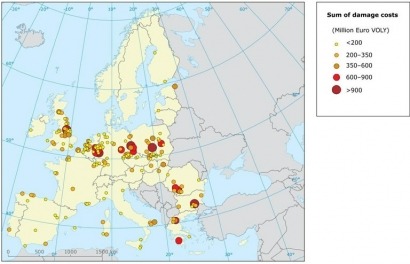
The EEA has published its latest report entitled ‘Revealing the costs of air pollution from industrial facilities in Europe’, which it explains reveals some of the hidden costs of pollution by using existing tools employed by policy-makers to estimate harm to health and the environment.
“Our analysis reveals the high cost caused by pollution from power stations and other large industrial plants,” Professor Jacqueline McGlade, EEA Executive Director, said. “The estimated costs are calculated using the emissions reported by the facilities themselves. By using existing tools employed by policy-makers to estimate harm to health and the environment, we revealed some of the hidden costs of pollution. We cannot afford to ignore these issues”, added Professor McGlade.
The industrial facilities covered by the analysis include large power plants, refineries, manufacturing combustion and industrial processes, waste and certain agricultural activities. Emissions from power plants contributed the largest share of the damage costs (estimated at €66–112 billion). Other significant contributions to the overall damage costs came from production processes (€23–28 billion) and manufacturing combustion (€8–21 billion). Sectors excluded from the EEA analysis include transport, households and most agicultural activities – if these were included the cost of pollution would be even higher.
Key findings:
The report uses publicly-available data from the European Pollutant Release and Transfer Register (E-PRTR). The analysis builds on existing policy tools and methods, such as the methods developed under the EU’s Clean Air for Europe (CAFE) programme. Based on the different methodologies, it calculates a range of estimated damage costs arising from air pollutant releases reported by nearly 10 000 individual facilities to the E‑PRTR.
The pollutants examined are regional air pollutants (NH3, NOx, PM10, SO2, volatile organic compounds (NMVOCs)), heavy metals (arsenic, cadmium, chromium, lead, mercury and nickel), organic micropollutants (benzene, polycyclic aromatic hydrocarbons (PAHs) and dioxins & furans), and CO2.
Certain aspects of harm to health and the environment are excluded from the scope of this study, such as the health and safety aspects associated with occupational exposure to air pollutants. For regional air pollutants for example, the model framework underpinning the assessment should be extended in the future to include aspects such as a valuation of ecological impacts and acid damage to culturally significant buildings and monuments. The recognised benefits of industrial facilities, including manufacturing products, employment and tax revenues, are not addressed in the report.
It is important to note that the report does not assess whether the emissions from industrial facilities included in the E-PRTR are consistent with the legal permitting conditions for the operation of these plants. The EEAA has also produced a summary of the report for policymakers.
The EEA has recently released a number of other publications addressing various aspects of air pollution in Europe. These include the ‘Air Quality in Europe – 2011’ report summarising Europe’s air quality status, the ‘Transport and Environment Reporting Mechanism (TERM)’ report that explores the environmental impact of transport, and ‘Air pollution impacts from carbon capture and storage (CCS)’ assessing the potential impacts on air pollutants from the introduction of CCS in Europe.
[Inset: Locations of the 191 E-PRTR facilities that contributed 50 % of the total damage costs estimated in 2009]
For additional information:
Revealing the costs of air pollution from industrial facilities in Europe

